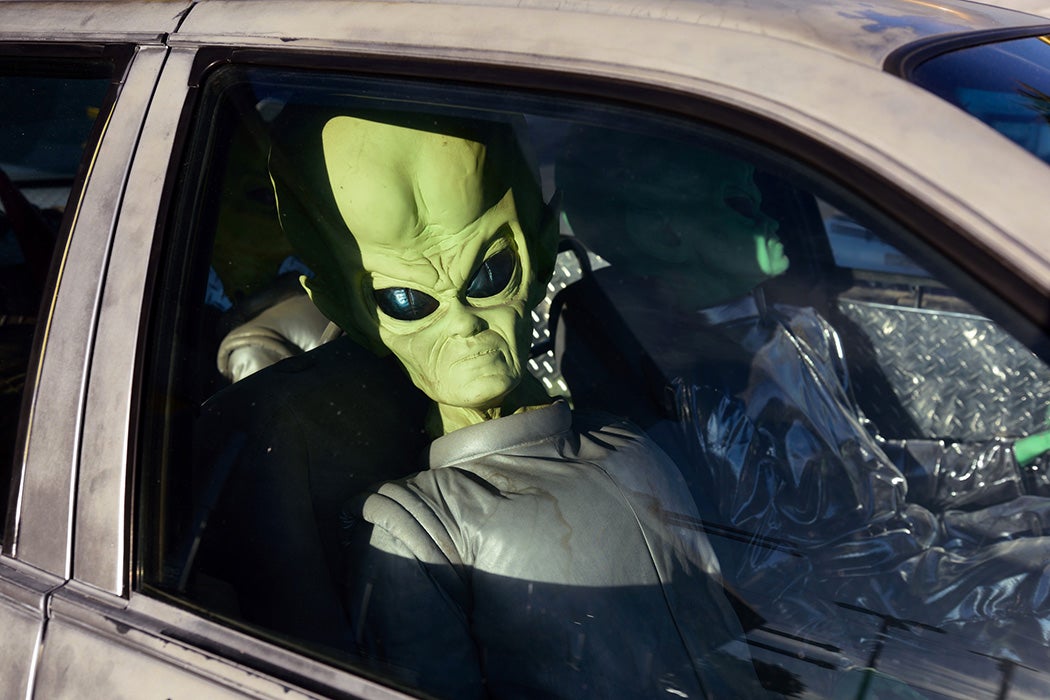In a few months, the Mars rover will land on the red planet and begin its search for microbial life. Recent news about Venus’s atmosphere has awakened speculation about the possibility of microbes living in the clouds. But as extraterrestrial life forms go, microbes are much less exciting than the stereotypes of “aliens” in our collective imagination: little men with sickly green or gray skin, big eyes, and tiny, shriveled arms. Where did these images come from?
Nothing has played a bigger role in shaping the classic “alien” archetype than the UFO contact movement. According to sociologist Chris Bader, “beliefs about what the aliens are like and the purpose of their visits to Earth have changed numerous times.” Many of the most iconic aliens of each decade started as famous “reports” of abductions and alien contact.
“The first person to claim extended interaction with aliens said that they were friendly, helpful, even noble beings,” writes Bader. In 1952, one George Adamski ran into Orthon, a five-feet-six-inch humanoid in a brown jumpsuit who hailed from Venus. Orthon was the first in a series of encounters with aliens who “resembled earthlings in every way,” writes Bader. “The beings spoke near-perfect English… They managed to hold down jobs [on Earth] by visiting their home planets only during work holidays.” Throughout the 1950s, many contactees referred to aliens as their peaceful “Space Brothers.”
In the 1960s, “contactees” gave way to “abductees.” The aliens became more malevolent and their forms more inhuman. Brady lists several reports: One described a “human-sized black figure, headless, with webbed feet and wings like a bat.” Another alien had “glowing red eyes, long hair, a hooked nose and grey skin.” Another was a “three- to four-foot-tall eye-less ‘white thing’ that ran sideways.” One particularly dashing creature wore a “black coat and wide-brim hat pulled down over a face that looked as if it had been covered with masking tape.”
“Reports of UFO occupants used to differ as widely as the human imagination,” writes Bader. This variation was so extreme that American UFO researchers feared it could undermine the legitimacy of their movement. So, in 1987, the president of the Mutual UFO Network studied thousands of UFO occupant encounters and concluded that there were only four types of alien beings visiting Earth: a small humanoid, “an experimental animal,” a human-like entity, and the “robot.” Any other type of report could be dismissed as a hoax.
Weekly Newsletter
By 1995, the UFO community rallied almost unanimously behind a creature called the “Grey,” writes Bader. This creature is “short in stature, with white or gray skin, a large head with huge cat-like eyes, a slit mouth and small nostrils, and thin, clawed limbs.”
While we were busy imagining aliens, scientists discovered faint signals of phosphine gas in the clouds of the famously harsh, seemingly uninhabitable planet Venus—a signature that could indicate the presence of life. Even if they won’t find Orthon or his peaceful brethren, one thing is clear: We have barely begun to scratch the surface of what aliens might actually be.
Support JSTOR Daily! Join our new membership program on Patreon today.







